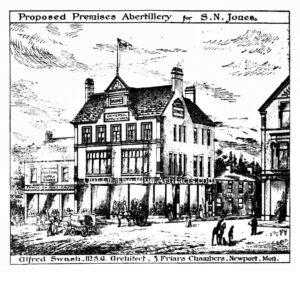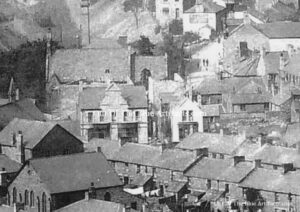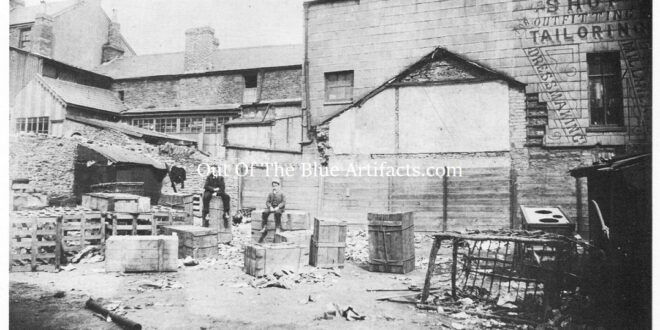The Arcade, Abertillery.
There were buildings in and around the area what we now know as the arcade from the early build-up of the town, a few cottages, yards and open spaces occupied the area behind the Pontlottyn Store (as seen in the image above). Commercial Street was known as part of the main shopping area along with Market Street and Somerset Street.
Long before the Foundry Bridge was erected the junction at the Bush Inn on High Street was the gateway into town. There were cottages along the main road opposite the National School, they were named St Michael’s Row, these cottages were occupied on early censuses, and they also featured on the 1880 ordnance survey maps, they were later demolished to construct the arcade buildings, I believe a small cottage was left intact which much later became the premises occupied by Ash & Son Saddlers, the cottage and was set back from the other buildings although was later built out to the road-line to follow the others, there is a photograph taken in 1905 showing this.
The Reading Rooms.
In 1856, Sir Thomas Phillips and Messrs T. P. & D. Price (Penybont Colliery owners) along with Mr John Conway (Abertillery Tin Works proprietor) set up the first reading rooms at Abertillery. The reading rooms were in a rented premises owned by Mr William Hiley, a grocer and draper of Abertillery, the rooms were somewhere in the area where the arcade would later be built. These reading rooms were only there a short while until a room became available at the newly built National School. The reading rooms at the school were moved into a new premises, purpose built in the mid 1880’s by Mr T. W. Powell of Powell’s Tillery Colliery Company’s Reading Rooms on Tillery Street, Abertillery. (More information below).
Later, Mr Buckley had a furniture store in the area and held auctions in the large yard (as seen in the main featured image above) in the area behind the old Pontlottyn Store that was used for such purpose. Mr Dolman a solicitor also had chambers there. Mr Edward Jones (ex-postmaster) had a grocery and provisions business and premises there too.
Mr Edward Jones Shop.
Mr Edward Jones shop was in Commercial Street, a premises that would later be on the corner of the Arcade with its frontage in Commercial Street. It was originally a grocers and post office which he opened after he finished as postmaster while at Pond House and Station Platform. Mr Edward Jones got into financial problems while at the shop and his son Mr Samuel Nathan Jones, came home and took the business over.
 Mr Samuel Nathan Jones New Shop.
Mr Samuel Nathan Jones New Shop.
In the early 1890’s Mr Samuel Nathan Jones had a new premises built on Commercial Street, Abertillery. This new building was opposite Carmel Street and served as a drapery, hosiery, clothiers and tailors shop. It was a large building (as seen in the etching left) taken from the South Wales Gazette.
It was designed by Mr A. Swash, architect of Newport, South Wales, put to Mr Jones in the December of 1891 and was printed in the South Wales Gazette on Friday 18th of December 1891.
The building of the new drapery store went ahead and took a commanding position on Commercial Street on the lower corner of what was later to become the new Abertillery Arcade.
 The Arcade Proposal.
The Arcade Proposal.
In the mid 1890’s, Mr Samuel Nathan Jones was instrumental in constructing the Arcade, Abertillery. Mr Jones put forth plans as a private undertaking to renovate the land behind the old Pontlottyn Store and had an idea to have a proper covered walkway arcade with shops each side and to transform it into a shopping arcade. The plans were accepted and the conversion building project went ahead, it coincided with the complete re-building of the Pontlottyn Store. At this time the whole area around High Street, Commercial Street and Somerset Street had a massive transformation.
The Abertillery Arcade.
The construction of the Arcade took over two years, it began in about 1896 and it was completed in December 1898. The photograph, circa 1986, shows Mr Jones’ shop (center left) and what seems to be the beginning of the construction of the Arcade.
The Opening of the Arcade.
On Saturday 6th of March 1897, the Merthyr Express reported on an Abertillery Council monthly meeting, those attended were as follows – Mr J. T. Williams (Chairman); Mr George C. Dancey; Mr W. Thomas; Mr G. Gregory; Mr J. Wallace; Mr J. T. Baker; Mr W. Stewart; Mr J. Tarrant; Mr Daniel Lewis; Mr J. A. Shepard (Clerk); Mr Gough (Assistant Clerk); Mr J. McBean (Surveyor); Mr D. Edwards (Collector) and Mr F. Padfield (Inspector):
At this meeting Mr Samuel Nathan Jones attended before the committee and asked for an extension of the gas and water mains through the Arcade and that the council light the Arcade with public lamps. It was agreed to do so and to fix three incandescent lamps through such, providing the Arcade be thrown open to the public night and day, that no gates be erected and that the council accept no responsibility with regard to the road through the Arcade.
In April 1897, Mr S. N. Jones met with the council committee to with regard to the drainage of his Arcade. It was reported they could not accede to his request as it was private property. It was said, the surveyor could extend the sewer to the curb outside his arcade to enable him to drain into the same.
 The Completion of the Arcade as a Shopping Centre.
The Completion of the Arcade as a Shopping Centre.
In December 1898 it was reported that the Abertillery Arcade project was nearly complete and ads were printed for the various leases of the shops. Mr Buckley sold his furniture premises to Mr Joseph Falkman, Mr Falkman a furniture retailer and Mr C. W. White & Sons, ironmongery store were the first two businesses to be established in the Abertillery Arcade.
A List of the First Shops to Occupy the Arcade.
In December 1899 the shops were occupied and the list of the first shops trading inside the arcade were as Follows – Messrs G. D. Cattee,Fish and Fruit Stores. Messrs Bracchi & Co, Ices and Refreshments. Mr C. W. White & Sons, Ironmongery Store. Mr S. N. Jones, Grocers. Messrs Adams, Gents Clothing. Messrs Roderick, Confectioners. Mr Hanney’s, Tobacco and Toys. Messrs South’s, Fruitier’s. Mr Austin, Booters. Messrs Summers, Meat and Provisions. Mr Price, Chemist. Mr Williams, Hairdressers and Messrs J. Falkman & Co. (as seen on the original advertisement left).
The Oldest Arcades in Wales.
At the time of its opening in 1898, the Arcade at Abertillery was the tenth oldest arcade in Wales, there were nine built before its construction. Following is a list of the oldest arcades in Wales, which are all located in Cardiff and Newport – The Old Arcade, Cardiff (1835). The Royal Arcade, Cardiff (1858). The Queen Street Arcade, Cardiff (1866). The Market Arcade, Newport (1869). The High Street Arcade, Cardiff (1885). The Castle Arcade, Cardiff (1887). The Wyndham Arcade, Cardiff (1887). The Central Arcade, Cardiff (1891) and Morgan’s Arcade, Cardiff (1896).
Over the years many retailers traded from the Abertillery Arcade (More information to come on the individual traders).
The Story of Mr Samuel Nathan Jones.
Following is a Link to – Mr Samuel Nathan Jones.
The Storm of March 1933.
In March 1933 severe weather swept across the United Kingdom and the town of Abertillery came to a standstill. On the Friday trains were halted on the railway tracks down through the valley because of 12′ foot snow drifts. In the Arcade the glass roof broke under the tremendous weight of snow.
The Refurbishment of the Arcade.
On Thursday 27th of February 1992, the Gwent Gazette reported that the Abertillery Arcade was to have a facelift costing more than £900,000 as part of a regeneration programme to transform the town and to improve local economy. The refurbishment of the Arcade is the latest phase of the work of “Abertillery Action”, a partnership between the Welsh Development Agency, Gwent County Council and Blaenau Gwent Borough Council, which has already seen £750,000 worth of projects in the town in the last three years.
The Renovation.
Under the refurbishment scheme, the renovation will include a complete exterior facelift, new shop fronts, a new Arcade floor and roof wit a complete interior conversion of the upper level flats under a “Living Over The Shops” scheme.
Town Crier.
To mark the first phase of refurbishment this week, the town crier Mr Andrew Downey will ring out the good news.
The Architect.
The architect was Mr Christopher Lambert-Gorwyn of Avonside Partnership, Bristol. He also designed a cast iron plaque to commemorate the deep pits in the area.
(More information to come).
Source – Monmouthshire Merlin, South Wales Gazette and the Gwent Gazette.
Points of interest – In 1856 Sir Thomas Phillips, Mayor of Newport helped Messrs T. P. & D. Price (Tillery Colliery owners) and Mr John Conway (Tin Works), along with the help of the Iron Masters Messrs James Brown and his brother Thomas Brown of Blaina (then ex-owner of the Cwmtillery Colliery) set up a Reading Room in Abertillery to educate the workforce of the town. Sir Thomas Phillips fought for the Welsh language and the group of gentlemen rented a room from a Mr William Hiley, a grocer and draper of Abertillery, who had property where the Arcade is today, Mr William Hiley was the father of Mr George Lewis Hiley, auctioneer and grocer of Abertillery.
The Reading Room was later placed into the National School and later again into the Powell’s Tillery Workmen’s Hall on Tillery Street and later still the new Powell’s Tillery Workmen’s Institute on Division Street. Mr William Hiley also owned much land in the area and a Stone Quarry, from which stone was taken to build the second Oddfellows Arms, somewhere in Abertillery in 1862.
Sir Thomas Phillips.
Sir Thomas Phillips was born in Ynys y Garth, Clydach near Gilwern in 1801. He entered the law profession and later became a Barrister. He was Mayor of Newport in 1839-1839 and was caught up in the Chartists Riots at the Westgate Hotel where he was shot in the arm and groin. He was given a Knighthood for his participation in quelling the uprising, also given the freedom of London. Mr T. Phillips retired to live at Llanellen House, Abergavenny. He became very passionate in helping the Welsh people, preserving the Welsh language and helped set up libraries to promote such.
 Out Of The Blue Artifacts A Library of a lifetime of collecting
Out Of The Blue Artifacts A Library of a lifetime of collecting
